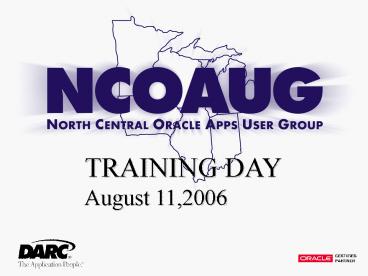TRAINING DAY - PowerPoint PPT Presentation
1 / 27
Title:
TRAINING DAY
Description:
... repetitive schedules), suggested repetitive schedules, nettable quantity on hand. Committed demand = sales orders, component demand (from planned orders, discrete ... – PowerPoint PPT presentation
Number of Views:38
Avg rating:3.0/5.0
Title: TRAINING DAY
1
TRAINING DAY August 11,2006
2
Simplifying Oracle Available to Promise
- Ted Paetkau
- Implementation Consultant
- DARC Corporation
3
Agenda
- Overview
- Definitions
- ATP Methods
- ATP Based on Planning Output
- ATP Based on Collected Data
- ATP From Order Management
- Single Level Supply Chain ATP
- Summary
4
Overview
- Oracle Global Order Promising
- based on the current and projected demands and
supplies across a supply chain and on an extended
supply chain, determines when a customer order
can be fulfilled. - ATP Planned production - committed demand
5
Overview
- Planned production planned orders, scheduled
receipts (purchase orders, jobs, and repetitive
schedules), suggested repetitive schedules,
nettable quantity on hand. - Committed demand sales orders, component demand
(from planned orders, discrete jobs, suggested
repetitive schedules, and lot expirations).
Committed demand does not include forecasted
demand.
6
Global ATP Methods
GLOBAL ATP
Based on Planning Output (Must have ASCP)
Based on Collected Data (Transaction Data)
Basic ATP
Basic ATP
Multi-Level Supply Chain ATP
Single Level Supply Chain ATP
Allocated ATP
7
ATP Based on Planning Output
- Basic ATP
- Only 1 inventory organization
- Multi-Level Supply Chain ATP
- Availability throughout a multi-level supply
chain - Capable to Promise (CTP)
- availability of component materials and resources
- Capable to Deliver (CTD)
- Transportation lead times (but not transportation
resources yet) - Allocated ATP
- Allocates supply by sales channel or customer
8
ATP Based on Collected Data
- Basic ATP
- 1 ship from location
- Single level supply chain ATP
- Multiple ship from organizations
- Recommends best shipping organization based on
sourcing rules - Does not recommend source for ATO Models, ATO
Items, or PTO Models
9
ATP From Order Management
1. Setup a latest schedule limit defaulting rule
in Order Management. If the date returned by ATP
is earlier than the request date plus the latest
schedule limit, the return date is automatically
populated in the ship date field when the order
is booked.
10
ATP From Order Management
2. Setup ATP for the item in the order
management tab of the item master. Also, specify
the ATP rule that will be used.
11
ATP From Order Management
3. Configure an ATP Rule. The rule specifies
what will be considered supply and demand for the
ATP calculation. Also specifies time when supply
will be assumed infinite.
12
ATP From Order Management
4. Enter an order. The sourcing warehouse is
populated based on Order Management defaulting
rules
13
ATP From Order Management
5. Check for availability. When the
availability button is clicked, the ATP process
returns the date when the material will be
available.
14
ATP From Order Management
6. Schedule the Order. When the order is
booked, the available date returned by ATP is
populated in the schedule ship date field.
15
Single Level Supply Chain ATP
1. Set the system profile INV Capable to
Promise to ATP Based on Collected Data
16
Single Level Supply Chain ATP
2. Set the MRP ATP Assignment Set profile
option to the assignment set that contains the
items sourcing rules
17
Single Level Supply Chain ATP
3. Setup sourcing rules. These determine the
order in which organizations will be looked at to
check availability. In this sourcing rule,
organization M1 will be checked first. If the
item is not available there, D2 will be checked
and so on.
18
Single Level Supply Chain ATP
4. Attach the item and sourcing rule to the
Assignment Set that was defined in the MRP ATP
Assignment Set profile option
19
Single Level Supply Chain ATP
5. Perform a collection from Order Management.
20
Single Level Supply Chain ATP
6. Enter an order.
21
Single Level Supply Chain ATP
7. In this case, org M1 does not have the
required availability of item AS66311 but org D2
does.
22
Single Level Supply Chain ATP
8. Delete the sourcing warehouse that populates
from Order Management defaulting rules.
23
Single Level Supply Chain ATP
9. Now, ATP returns D2 as the source warehouse
and July 24 as the available date
24
Single Level Supply Chain ATP
10. When the order is booked, D2 is populated in
the shipping warehouse field and the available
date populates in the schedule ship date field.
25
Single Level Supply Chain ATP
11. The supply/demand form for item AS66311 now
shows the quantity available for ATP has
decreased by the amount of the sales order
26
Summary
- Comprehensive picture of supply available to fill
customer orders - Based on collected data
- Single or multiple shipping organizations
- Based on planning output
- Multi-level supply chain
- Capable to Promise
- Capable to Deliver
- Allocated ATP
27
Simplifying Oracle Available to Promise
- Ted Paetkau
- Implementation Consultant
- DARC Corporation































